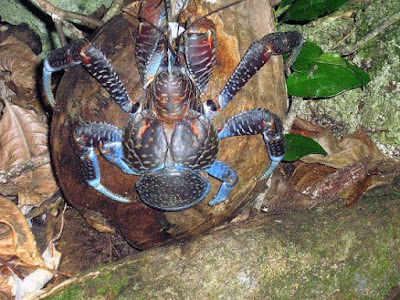Crustaceans Make Evolutionists Crabby
If you are ever in Hawaii or some South Pacific islands, you might take a stroll outside some night and hear a crunching sound. Before you light a shuck out of there, it may be something as benign as the coconut crab. It's also called the robber crab or palm thief, but it's doing it's thing, not robbing anything, really. Big critters, and they really do like coconuts (and other things). Some folks consider them good eating, but stick to other crab meat, because these are endangered. They like to use their pincers, so I'd be careful.
This is one of the more notable species of crab. There are many, and they fit into the category of crustaceans. Adherents to the universal common ancestor mythology experience discomfort because there are no plausible, consistent origin stories, and there is considerable disagreement about the origin and classification of crustaceans. Like other branches of the evolutionary family "tree of life", their branch is in a state of confusion. If secularists would drop the evolution notion and realize that life is the product of our Creator, they might sleep better at night. Except for the coconut crunching, of course.
 |
| Credit: Wikimedia Commons / fearlessRich |
To read the rest of this short article, click on "The robber crab — Part of the great crustacean mystery". There are some other articles linked at the end for additional reading.Did you hear about the crab that climbs trees at night to steal coconuts? It’s no joke. If you visit Christmas Island in the Indian Ocean, or some other south-west Pacific and Indian Ocean islands, you can see the robber crab in action.The robber crab, Birgus latro, is the world’s largest land crab. It can grow to 60 cm (2 ft) or more from head to tail. It sneaks out of its burrow at night, climbs the trunks of coconut palms or other fruit trees, and snips off the coconuts or fruit with its two giant pincers. It climbs back down the tree and gathers up the food it dropped for a tasty salad. It uses its huge pincers to chip at and pound the coconuts until it gets them open.